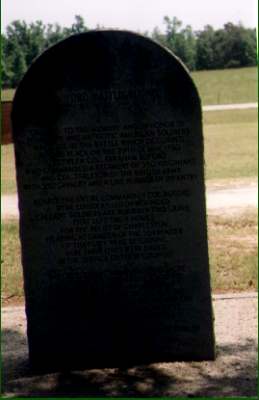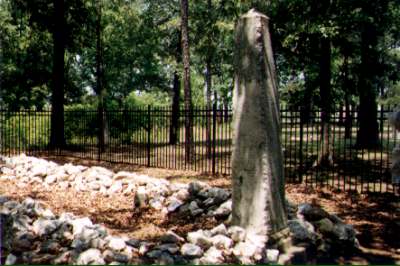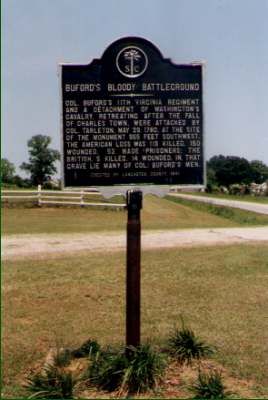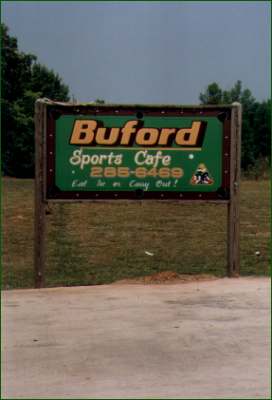


| [ Previous ] [ Next ] |

|
Unlike the elaborate displays at Brattonsville, the site of Ban's victory over Abraham Buford on May 29th, 1780 doesn't rate a park -- more of a parkette off to the side of the road, with a memorial to mark one of the common graves from the battle.
| The first thing you see as you approach along the highway is this wall which stands on the verge. I have read that it was erected by the local high school kids. |

|
Behind the wall is this monument, placed on the site in 1955 by the D.A.R. It repeats all the errors of the original 1860 monument. The strength of the forces involved on both sides are wrong. (Buford had more than 400 men; Tarleton roughly 250.) And designating Charles Stedman -- who provided the final quote -- as a "British historian " is dubious to say the least. He was a loyalist who served as Lord Cornwallis's commissary officer, and his book on the war was published in the midst of the general round of literary mudslinging that took place during the post-war feud between Sir Henry Clinton and the Lord Cornwallis. (Tarleton was part of Clinton's faction; Stedman was part of Cornwallis's.) Needless to say, the sign neglects to mention that Buford was given a chance to surrender honorably without losing a man, or that he was courtmartialled after the battle. Well, at least they don't say he was "cut down with his men " -- an all-too-common piece of idiocy that can be found even in a few recent books. (As my buddy Stacy -- a descendent of Buford's brother -- is wont to comment, if Ggggggreat Uncle Abe died at Waxhaws, then his zombie homesteaded after the war.)1

|
The text hard to decipher the text in this scan of the photo, unfortunately. It reads: BUFORD BATTLEGROUND |
| The far-more-attractive -- if equally inaccurate -- original monument, dedicated in 1860, stands nearby within an iron fence that marks the location of the largest of the two common graves on the site. The location of the second common grave for the rebel casualties is unknown. (Presumably there is also a third, for the men Tarleton lost, though it never gets mentioned.) |

|

|
This simple notification is considerably more rational (though Buford's force was actually a mixed brigade drawn from a variety of regiments, not just his own command): "Col. Buford's 11th Virginia Regiment and a Detachment of Washington's cavalry, retreating after the fall of Charles Town, were attacked by Col. Tarleton, May 29, 1780, at the site of the monument 955 feet southwest. The American loss was 113 killed, 150 wounded, 53 made prisoners. The British, 5 killed, 14 wounded. In that grave lie many of Col. Buford's men. |
|
After we'd looked around the monuments, we headed on up the road to have
lunch at the infamous Buford Sports Café. Holley and Doc M visited
there in 1999, and I finally got to explore the reality behind their stories. The food
is pretty good in a truck-stop way, and the atmosphere is everything they've
described. Pinball machines, pool tables, photos of Elvis and Marilyn Monroe
by the dozens, and a long list posted on the wall behind the bar, naming all
the locals who are currently barred from the place for brawling.
Over lunch we discussed the odds that anyone working there had a clue on the identity of the Buford who provided the name of the bar and the gas station/convenience store next door. Holley finally opted for asking the waitress if many people dropped in after visiting the battlefield. Her reaction: "What battlefield?" (I had a note from a resident of Buford, South Carolina, who assures me this isn't a typical local reaction.) |

|
After lunch we headed onwards to Camden.
| [ Index ] | [ Previous ] [ Next ] |
1 As an example of such fiction, see Irving Werstein, 1776: The Adventure of the American Revolution told with Pictures (New York: Cooper Square Publishers, Inc., 1965), p112: "...Tarleton's Tories massacred the Americans even after Buford indicated surrender. He was cut down asking quarter for his men." In reality, Buford got nary a scratch in the battle, and died at a ripe old age in 1833 -- having outlived Tarleton by about six months. [ back ]
| Return to the Main Page | Last updated by the Webmaster on January 30, 2004 |